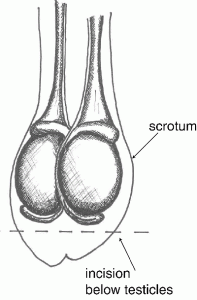FA youngstock processing
How to – Open castration
Indications
Calf, lamb and piglet castration is typically performed on farm by the producer or an employee. However, many goat owners would prefer a veterinarian castrate their pets and many farm animal rescues are in need of assistance.
Relevant anatomy

Preoperative management
Food restrictions: NA
NSAIDs/analgesics: NSAIDs should be given preoperatively. For young calves, meloxicam added to the milk ration 3 hours prior to the procedure provides analgesia.
Antibiotics: NA
Tetanus prophylaxis is recommended.
Local blocks: Cord block, testicular block or epidural.
Position/preparation: Standing or recumbent. Goats should be sedated for the procedure.
Surgery Supplies:
- Scalpel blade or Newbury knife
- Emasculators (depending on age)
- Suture 0 absorbable (depending on age)
Surgical procedure
The testicles are pushed toward the body and the distal third of the scrotum removed with a sharp incision. The testicles should drop out of the scrotum. Depending on the age of the animal, the testicle can be pulled off using gentle traction (creating hemostasis by traumatizing the vessel), emasculated or ligated and transected
Postoperative care
- NSAIDs should be continued for 1-3 days to optimize recovery
- Monitor for incisional issues (infection, evisceration) and animals going off feed
Complications
- Evisceration (rare)
- Infection (rare)
Videos
Resources
Newbury knife and Henderson drillhttps://youtu.be/qWE0LIdzU8E?si=UVcYMUqzMwqmoHfi

